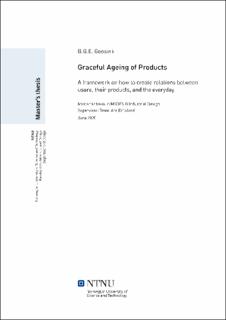| dc.description.abstract | Products, regardless of their utility, face the challenge of time. Whether it is through wear and tear, changes in personal and societal values, or incompatibility with unforeseen technological advancement, very few designs last a life time. This thesis title proposes to challenge this convention, exploring the principles of design that encourage the graceful ageing of products. This refers to products that stand the test of time by keeping hold of their value in the eyes of their owner and user, being or becoming keep-worthy.
Focus of this thesis lies on the aspects of design that impact the perceived worth of products as they age. The emphasis of this research lies on uncovering factors that improve a product beyond aspects initially considered by users during purchase.
The motivation for this thesis proposal is two fold. Firstly, it is about understanding graceful ageing of products in the pursuit of good design. Secondly, items that last confront today's standard product lifecycle and consumeristic lifestyle. Lasting products create less need for replacement. Gracefully ageing products create less want for replacement, encouraging a mindset of fostering and repair. In the wake of climate change, a mindset shift in consumeristic behaviour would be an encouragement in the right direction.
The outcome of this thesis is a framework that constitutes the elements needed in design to enable graceful ageing. The principle hypothesis of the framework is the notion that the stories we build around our everyday items makes them unique, and that this uniqueness makes our products worth keeping. The framework proposes building aesthetic interaction on the existing ideas around 'good design', namely user values, utility, and emotion. Products often loose their novelty after several use cases, and fade into the background of everyday life. Aesthetic interaction is proposed as a method to preserve salience, for the user to have enough awareness of the products presence in their daily activities, enabling the product to eventually become part of the all important user narratives, memories and stories. | |
